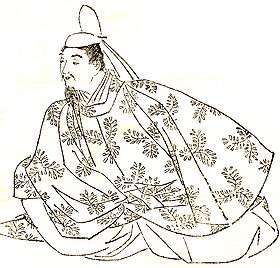Fujiwara no Yoshifusa

Fujiwara no Yoshifusa (藤原 良房, 804 – October 7, 872), also known as Somedono no Daijin or Shirakawa-dono, was a Japanese statesman, courtier and politician during the Heian period.[1]
When Yoshifusa's grandson was enthroned as Emperor Seiwa, Yoshifusa assumed the role of regent (sesshō) for the young monarch.[1] He was the first sesshō in Japanese history who was not himself of imperial rank; and he was the first of a series of regents from the Fujiwara clan.[1]
Career
He was a minister during the reigns of Emperor Ninmyō, Emperor Montoku and Emperor Seiwa.[1]
- 834 (Jōwa 1, 9th day of the 7th month): Sangi
- 835 (Jōwa 2): Gon-no-Chūnagon
- 840 (Jōwa 7): Chūnagon
- 842 (Jōwa 9): Dainagon
- 848 (Saikō 1, 1st month): Udaijin [2]
- 857 (Saikō 4, 19th day of the 2nd month): Daijō Daijin[3]
- 858 (Ten'an 2, 7th day of the 11th month): Sesshō for Emperor Seiwa.[4]
- October 7, 872 (Jōgan 14, 2nd day of the 9th month): Yoshifusa died at the age of 69.[5]
Yoshifusa conceived the programme of boy-sovereigns with Fujiwara regents; and his adopted son, Mototsune, carried out the plans.[6]
Genealogy
This member of the Fujiwara clan was the son of Fujiwara no Fuyutsugu.[1] Yoshifusa's brothers were Fujiwara no Nagayoshi,[7] Fujiwara no Yoshisuke[8] and Fujiwara no Yoshikado.[9]
Marriages and children
He was married to Minamoto no Kiyohime (源 潔姫), daughter of Emperor Saga.
They had only one daughter.
- Akirakeiko/Meishi (明子) (829-899), consort of Emperor Montoku
He adopted his brother Nagara's third son.
- Mototsune (基経) (836-891) - Daijō Daijin and Kampaku
Yoshifusa is referred to as Chūjin Kō (忠仁公) (posthumous title was Daijō Daijin).
See also
- Fujiwara Regents
- Shoku Nihon Kōki, one of the Six National Histories of Japan; edited by Fujiwara no Yoshifusa.
Notes
- 1 2 3 4 5 Nussbaum, Louis-Frédéric. (2005). "Fujiwara no Nakahira" in Japan Encyclopedia, p. 212, p. 212, at Google Books; Brinkley, Frank et al. (1915). A History of the Japanese People from the Earliest Times to the End of the Meiji Era, p. 203., p. 203, at Google Books
- ↑ Titsingh, Isaac. (1834). Annales des empereurs du japon, p. 135., p. 135, at Google Books; see "Fousiwara-no Yosi fousa", pre-Hepburn romanization
- ↑ Titsingh, p. 114., p. 114, at Google Books; Brown, Delmer et al. (1979). The Future and the Past, p. 285; n.b., Yoshifusa was the first minister to be promoted to Daijō-daijin. That high office was previously filled by Imperial Princes only.
- ↑ Brown, p. 286.
- ↑ Titsingh, p. 120., p. 120, at Google Books.
- ↑ Brinkley, p. 237., p. 237, at Google Books
- ↑ Brinkley, p. 203., p. 203, at Google Books
- ↑ Titsingh, p. 114., p. 114, at Google Books
- ↑ Florenz, Karl. (1906) Geschichte der japanischen Litteratur, Vols. 1-2, p. 208., p. 208, at Google Books
References
- Brinkley, Frank and Dairoku Kikuchi. (1915). A History of the Japanese People from the Earliest Times to the End of the Meiji Era. New York: Encyclopædia Britannica. OCLC 413099
- Brown, Delmer M. and Ichirō Ishida, eds. (1979). Gukanshō: The Future and the Past. Berkeley: University of California Press. ISBN 978-0-520-03460-0; OCLC 251325323
- (Japanese) Hioki, S. (1990). Nihon Keifu Sōran. Tokyo: Kōdansya.
- (Japanese) Kasai, M. (1991). Kugyō Bunin Nenpyō. Tokyo: Yamakawa Shuppan-sha
- (Japanese) Kodama, K. (1978). Nihon-shi Shō-jiten, Tennō. Tokyo: Kondō Shuppan-sha.
- Nussbaum, Louis-Frédéric and Käthe Roth. (2005). Japan encyclopedia. Cambridge: Harvard University Press. ISBN 978-0-674-01753-5; OCLC 58053128
- (Japanese) Owada, T. et al. (2003). Nihonshi Shoka Keizu Jimmei Jiten. Tokyo: Kōdansya.
- Titsingh, Isaac. (1834). Nihon Odai Ichiran; ou, Annales des empereurs du Japon. Paris: Royal Asiatic Society, Oriental Translation Fund of Great Britain and Ireland. OCLC 5850691